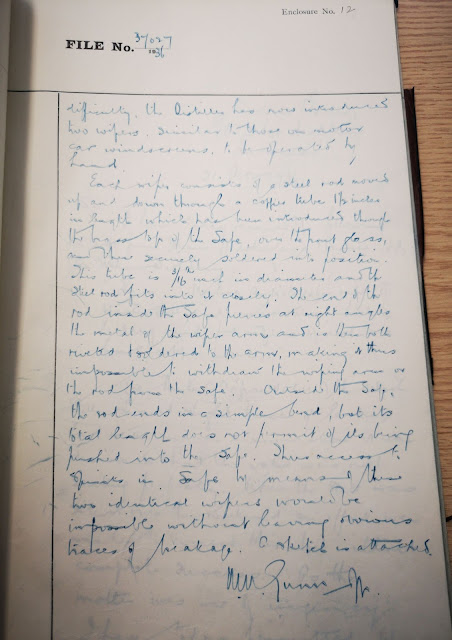Glen Mhor Log Book 3rd July 1936
There are various levels of whisky geekiness and some are uncharted. I suspect being excited about not just where the distillery water source and where the inlet pipe was exactly, is one shining example. Another is today's find which reveals a rather mundane change at Glen Mhor, but one that made the stillman's job much easier and that of the exciseman who would be observing him work. But I have to admit these little details add up and such a simple enhancement required such a level of detail, recognition and recording to be approved is indicative of how closely distillation was monitored.
The level of detail was required regarding this entry from July 1936, as the changes recorded affect the spirit safe. Not the internal workings, but rather their viewability. The concern from a Custom & Excise perspective was that any changes that threatened the security and enclosed nature of the safe would require special inspection.
What's also particularly cool about this find, is the fact it was written by Neil M. Gunn who takes us into great detail about the subject matter and throwing in a comparison about car windscreen wipers - don't worry, it'll all make sense by the end of this article. Seeing how Neil explored the Highlands in his younger days by motorcycle, he may have felt a touch of jealously towards a windscreen and wipers to protect drivers from the elements, something that his own journeys lacked.
We're continuing to explore the Glen Mhor Log Book (Highland Archives HCA/D31/4/1/25) and specifically, 1936, which seems a busy period at the distillery with various repairs and maintenance tasks being requested and approved during its silent season.
What's also of interest is the area of concern is abbreviated to L.W. & F. Receiver, which is the Low Wines & Feints Receiver. This reminded me we do have the spirit safe actually photographed, which says what it is on the metal exterior, but possibly a later variant? Or is this the same thing, as you can see from the image below:
Certainly, food for thought, and what about the suggestion of a former receiver in its place? Why was this removed? What was the benefit? The forthcoming 1898 proposed alterations do feature a proposed move of the spirit safe, but we'll tackle this in a latter article.
'3rd July 1936
Traders applications for final approval now attached (no.7)
No.2 Low Wines & Feints Receiver has been removed and demolished?, another L.W. & F. pipe runs direct from the Spirit Safe to the No.1 L.W.& F. Receiver. This pipe was made continuous by the introduction at the place where No.2 L.W.& F. Rec stood, a new piece of piping afforded to the old pipe by wiped joints.
The Sample Safe after explicit examination was found to be in good condition. All points and connections have been tightened and made thoroughly secure. It now stands on a table where No.2 L.W.& F. Rec was and is connected by a pipe, from underneath to the L.W.& F. pipe which empties into the L.W.& F. Receiver. This short connecting pipe is securely fixed into the bottom of the Sample Safe by wiped? solder and into the L.W.& F. pipe by a wiped? joint.
The clouding of the glass of the Sample Safe by spirit vapour or steam made it difficult, and I have frequently observed for the stillman to see with ease the readings of his hydrometers inside the safe. In an effort to overcome the (next page) difficulty, the Distiller has now introduced two wipers. Similar to those on the motor car windscreens, to be operated by hand.
Each wiper consists of a steel road moved up and down through a copper tube 1.5 inches in length which has been introduced through the brass top of the Safe, over the front glass, and thus securely soldered into position. This tube is 3/16 inch in diameter and the steel rod fits into it closely. The end of the rod inside the Safe ?? at right angles the metal of the wiper arm and is then both riveted & soldered to the arm, making it thus impossible to withdrawn the wiping areas or the rod from the safe. Outside the safe, the road ends in a simple bend, but its total length does not permit of its being pushed into the safe. Thus access to Spirits in Safe by means of the two identical wipers would be impossible without leaving obvious traces of breakage. A sketch is attached.
N.M. Gunn'
Is that a wiper in the photograph? If the problem endured, then such a simple (and approved) solution may have remained with Glen Mhor until the safe was replaced. As of yet, I have not recorded or found any mention of the spirit safe being changed, so we must presume that the wiper proved to be a simple but useful improvement.



Comments
Post a Comment